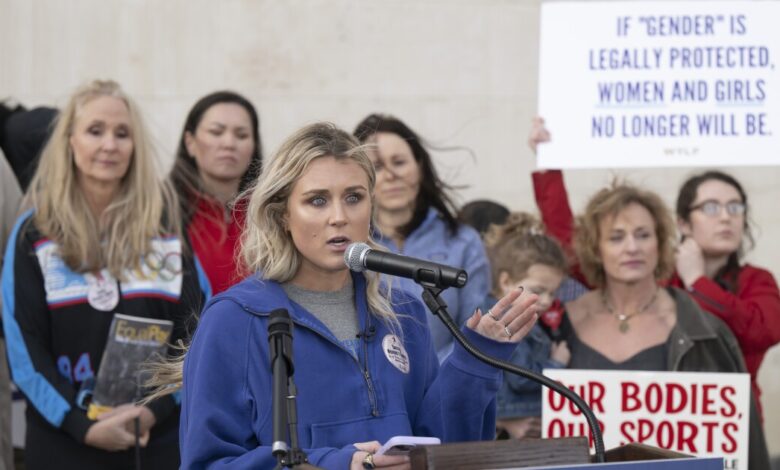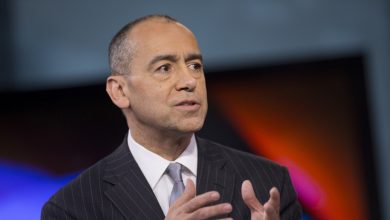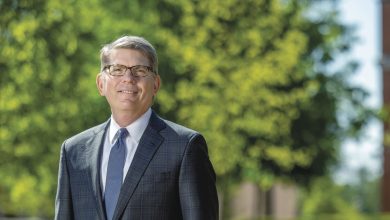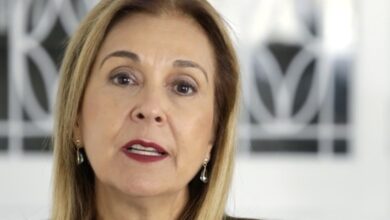More Students Endorse an Expansive Definition of ‘Harm.’ Colleges Aren’t So Sure.

[ad_1]
In April, a critic of transgender rights spoke at San Francisco State University, and as one might expect, students protested. They filled the hallway outside the room, shouting “Trans women are women!” and stomping their feet. After the event, as protests continued, police officers escorted the speaker to another room, where she was barricaded inside for more than three hours.
The speaker, Riley Gaines, a former collegiate swimmer who campaigns against transgender women’s participation in women’s sports, claimed while in lockdown that she had been assaulted by a “man dressed as a woman” after her speech. The Golden Gate Xpress, San Francisco State’s student newspaper, reported that none of their journalists had seen such an incident.
Gaines’s allegation of physical assault became a right-wing talking point; she even got a shout-out from U.S. House Majority Leader Kevin McCarthy, Republican of California. But for transgender students at San Francisco State, Gaines’s appearance was its own kind of harm, a reminder that they weren’t safe, not even on campus.
“Trans students don’t feel supported by the university right now, they don’t feel safe,” Jeremy Lark, a graduate student and assistant director of the Queer & Trans Resource Center at SFSU, told the Golden Gate Xpress. “This is the first case where I as a student leader have felt like I don’t have the institutional support to make these students feel safe.”
A series of recent campus-speaker flare-ups has highlighted how college students are redefining “harm” as something that threatens not only their physical safety, but also their emotional safety. While that’s not a new idea, experts say, today’s students are more attuned to potential impacts of harm.
With this expanded definition comes a greater expectation that colleges protect their students from threats to their psychological well-being, including by condemning certain speakers and canceling their appearances.
Not everyone is embracing this rhetoric. Leaning on the First Amendment or, in the case of private colleges, stated commitments to open expression, some college administrators are choosing to err on the side of free speech. To some students, that choice feels like a betrayal.
Without a breakthrough in the lines of communication between students and college leaders, tensions over harm — namely, what should qualify as harm and how campuses should respond — will persist.
‘Enraged, Upset, and Angry’
In demanding their campuses cancel or condemn visits by right-wing speakers, student activists often describe the physical and psychological dangers that they believe a speaker’s rhetoric could present to a marginalized group.
This spring, many clashes between students and speakers have involved activists who espouse anti-transgender beliefs. They’re visiting at a time when transgender rights are under near-constant debate: State legislatures are passing bills to restrict the kind of health care transgender kids can access and the sports teams they can play on. The Biden administration is expected to enshrine protections for transgender students in the regulation interpreting Title IX, the federal gender-equity law.
Research has repeatedly shown that transgender college students have much higher risks of depression, anxiety, and suicidal ideation than cisgender students.
What’s more, transgender students’ concerns about violence are real, said Lawrence L. Mullen, an English Ph.D. student at the University at Buffalo, part of the State University of New York system.
In March, Buffalo officials refused to cancel a speech by Michael Knowles, a conservative commentator who said recently that “transgenderism must be eradicated from public life entirely.” The campus chapter of Young Americans for Freedom had invited Knowles to give a speech on “radical feminism.”
We know from previous displays of hateful violence that people will travel states, they will travel miles, to be able to harm others.
The university’s graduate-student union issued a statement lamenting the decision, tweeting, “Permitting such a speaker to be on campus presents a clear and deliberate workplace safety concern to trans graduate workers.”
If someone wanted to hurt a transgender student, it would be pretty easy to find their information in a campus directory, said Mullen, who is president of the union. “We know from previous displays of hateful violence that people will travel states, they will travel miles, to be able to harm others,” Mullen, who identifies as nonbinary and transgender, said. “And so because this was open, we knew that anyone could show up.”
Students and community members peacefully protested Knowles’s appearance outside the venue before his speech began. No one was physically hurt at the event, but transgender students struggled to get back to their normal lives, Mullen said.
“I am one of those people, who presumably should be eliminated from public life,” Mullen said, referring to Knowles’s “transgenderism” comment. “I know I’m not alone in this. It’s such a difficult complex emotion to be able to articulate that is enraged, upset, and angry.”
College students are also using claims of harm to push back against certain campus policies and curricula, urging professors and administrators to factor student well-being into their decisions.
At Cornell University, the undergraduate-student government unanimously passed a resolution in March “imploring” instructors to put warnings on syllabi for traumatic content that could be discussed in class, such as sexual violence, racial hate crimes, and homophobic harassment.
The motivation was to support students with post-traumatic stress disorder, the resolution stated.
“A lot of older generations and much of the media has characterized content warnings as something for oversensitive students and snowflakes who refuse to interact with the real world,” said Claire Ting, a student leader who drafted the resolution.
But reading scenes of rape and violence can cause traumatized students to shut off while they’re trying to learn, Ting said.
“I don’t think it’s egregious to ask for a little bit more compassion in the classroom,” Ting said.
Defining Harm Claims
When students say they feel “harmed” by words or actions, or that words or actions “harm” others, it may come off as uncouth to question them, said Cass Sever, a visiting sociology professor at Mount Holyoke College. Sever studies harm claims, which she defined as allegations of emotional trauma made by one person against another.
Part of what makes the language of harm so compelling, Sever said, is that it is hard to disprove threats to emotional safety, especially at a time of increased attention to young people’s mental health.
“If I say I was emotionally abused, if you were to stand up and say, ‘No, you weren’t,’ that sounds absolutely absurd, if not malevolent,” Sever said. “So there’s no real viable response to someone claiming an emotional response or emotional harm beyond listening and supporting them.”
As some students see it, Sever said, psychic harm is a form of inequality that needs to be resolved before anyone can speak. Many administrators, meanwhile, don’t see harm the same way and are instead focused on guaranteeing free speech.
At Cornell, after the student government approved the resolution on trigger warnings, it was swiftly vetoed by Martha E. Pollack, Cornell’s president. In a letter, Pollack cited concerns about academic freedom, which grants faculty the right to determine what and how to teach. (Pollack elaborated on that view in a recent interview with The Chronicle.)
Brian Hamluk, vice president for student life at the University at Buffalo, acknowledged hearing from students who wanted Buffalo to cancel Knowles’s speech. In communications with students, the public university explained it had a responsibility to uphold the First Amendment. If there was a credible safety threat, “that would be a different matter,” Hamluk told The Chronicle.
“We never look down the path of canceling the speaker,” he said.
To some students, the free-speech argument is used in bad faith. How can trans and queer students meaningfully engage in civil discourse, they ask, if the opposing viewpoint does not believe in their right to exist?
“I see what’s happening in Florida, with censorship and removing the ability to teach and speak freely,” Mullen, at Buffalo, said, referring to legislative efforts to restrict how public colleges teach about race and fund diversity initiatives. “So I highly value freedom of speech. But I think that there are ways that you can still do that without allowing someone to come to your campus and say that an entire group of people should be erased from public life.”
Sure, Mullen said, Buffalo likely would have been sued by Young Americans for Freedom, the sponsor of Knowles’s speech. But a possible consequence, Mullen added, is that “you irreparably damage the culture that exists on your campus.”
Sever said she felt sympathy for both sides of the debate. She couldn’t think of any examples where students and campus leaders had managed to bridge the divide. (If you have, let us know).
Instead, there’s a lot of yelling and not a lot of listening, Sever said.
“There’s a lot of public intellectuals who are saying in public spaces, ‘we need to remember free speech,’” Sever said. “That’s not going to work. Because the folks who are claiming psychic harm do believe in free speech, they think they do. So that message is kind of going to fall on deaf ears.”
Madelyn Wessel, a former general counsel at Cornell and Virginia Commonwealth universities, noted that laws and campus policies do include protections against forms of emotional harm — but there’s a high standard to meet. When speech does rise to the level of targeted harassment, for example, it’s no longer protected under the First Amendment. Wessel now works as senior counsel at Hogan Lovells, a law firm, but was speaking in her personal capacity.
“Some advocates are pushing beyond these kinds of traditional ways of thinking about harmful interpersonal abuse or harassment towards a broader attempt to veto speakers altogether on a campus,” Wessel said, “because they’re saying things that an individual finds harmful or oppressive or horribly inaccurate.”
A Balancing Act
The challenge of balancing free speech and harm reduction is something Lynn Mahoney, the president of San Francisco State University, has been thinking about for many years.
In 2016, Mahoney was provost at California State University at Los Angeles when Donald J. Trump was elected as president. Historically, free speech has been more of a progressive cause, Mahoney told The Chronicle, leaning on her training as a U.S. historian. That changed when Trump was elected, and it became acceptable for “anyone to say anything, no matter how hurtful it was,” Mahoney said.
The campus was in deep pain. And Ben Shapiro had the best day of his life.
That year, a student group invited Ben Shapiro, a right-wing commentator, to speak on campus. Progressive groups demanded the university cancel the event, but it went on. A physical confrontation between Shapiro’s supporters and Cal State L.A. students and faculty members ensued.
“The campus was in deep pain,” Mahoney said. “And Ben Shapiro had the best day of his life. He made CNN. He made all the mainstream news. We had taken a minor player in right-wing media, and we had given him the best day of his life.”
From that, she adopted three principles for speaker events which she carried to the SFSU presidency: protect free speech, address the harm, and “keep these speakers from having the best day of their lives.”
Mahoney feels confident that the presence of Riley Gaines one night for a few hours should not make students feel unsafe on campus. The university rallied around transgender students before and after the event, Mahoney said. On the day of Gaines’s speech, the Queer & Trans Resource Center hosted a mixer to celebrate transgender and queer athletes.
“I can’t undo the emotional harm that a Riley Gaines does to trans women who want to participate in student athletics,” Mahoney said. “But I can at least hope that we provide the support to address that emotional harm.”
Amid strong feelings and sharp divides, Mahoney is trying to find a middle ground. So are students at Cornell.
Ting, the sophomore who wrote the resolution calling for mandatory trigger warnings on syllabi, said she saw some merit in Pollack’s concerns around academic freedom.
Ting and another student leader are now collecting faculty members’ perspectives before they draft another resolution. They’re considering an “ethical standard” instead of a full mandate.
“I can agree that a mandate would create a chilling effect to a degree,” Ting said. “I think the mandate opens up faculty to a lot of liability, and I think it can become a very slippery slope.”
[ad_2]
Source link






